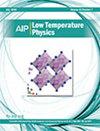The influence of zirconium dioxide nanoadditives on the properties of mullite-corundum
IF 0.8
4区 物理与天体物理
Q4 PHYSICS, APPLIED
引用次数: 0
Abstract
The paper analyzes the effect of nanoadditives of zirconium dioxide, partially stabilized by Y2O3, on the Al2O3–SiO2 matrix during hot pressing by the electroconsolidation method. The microstructure obtained at different compositions and sintering modes is studied. It was established that the introduction of nanopowder ZrO2–3 mol % Y2O3 increases the crack resistance of sintered samples not only due to the transformation of the tetragonal phase to the monoclinic phase, but also due to the formation of a solid solution with aluminum oxide at the interphase boundaries. Starting from a temperature of 1400 °C, complete densification occurs with the formation of nonporous composites while preserving the nanostructure. At this temperature, the formation of mullite with cristobalite phases also begins. The high value of thermocycles makes it possible to use this composite material as a cryogenic one. The fabrication of mullite-corundum composites with additions of ZrO2–3 mol % Y2O3 nanopowders via the method of electrosolidification has enabled the attainment of high fracture toughness, K1C = 14.5 MPa⋅m1/2, and hardness HV10 = 14 GPa. These results evidence excellent mechanical properties, thereby expanding the potential applications of this material.二氧化锆纳米添加剂对莫来石-刚玉特性的影响
本文分析了电固相法热压过程中部分由 Y2O3 稳定的纳米二氧化锆添加剂对 Al2O3-SiO2 基体的影响。研究了不同成分和烧结模式下获得的微观结构。结果表明,纳米粉体 ZrO2-3 mol % Y2O3 的引入不仅增加了烧结样品的抗裂性,这不仅是由于四方相转变为单斜相,还由于在相间边界形成了氧化铝固溶体。从 1400 °C 的温度开始,在保留纳米结构的同时,完全致密化并形成无孔复合材料。在此温度下,还开始形成莫来石和脆闪石相。高热循环值使得这种复合材料可以用作低温材料。通过电固化方法制造的莫来石-刚玉复合材料中添加了 ZrO2-3 mol % Y2O3 纳米粉末,从而获得了较高的断裂韧性 K1C = 14.5 MPa-m1/2,硬度 HV10 = 14 GPa。这些结果证明了该材料具有优异的机械性能,从而拓展了其潜在的应用领域。
本文章由计算机程序翻译,如有差异,请以英文原文为准。
求助全文
约1分钟内获得全文
求助全文
来源期刊

Low Temperature Physics
物理-物理:应用
CiteScore
1.20
自引率
25.00%
发文量
138
审稿时长
3 months
期刊介绍:
Guided by an international editorial board, Low Temperature Physics (LTP) communicates the results of important experimental and theoretical studies conducted at low temperatures. LTP offers key work in such areas as superconductivity, magnetism, lattice dynamics, quantum liquids and crystals, cryocrystals, low-dimensional and disordered systems, electronic properties of normal metals and alloys, and critical phenomena. The journal publishes original articles on new experimental and theoretical results as well as review articles, brief communications, memoirs, and biographies.
Low Temperature Physics, a translation of the copyrighted Journal FIZIKA NIZKIKH TEMPERATUR, is a monthly journal containing English reports of current research in the field of the low temperature physics. The translation began with the 1975 issues. One volume is published annually beginning with the January issues.
 求助内容:
求助内容: 应助结果提醒方式:
应助结果提醒方式:


